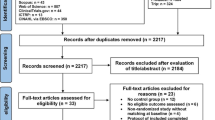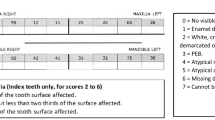Abstract
Dental age estimation (DAE) is one of the most reliable and useful scientific methods employed by forensic odontology (FO) for human identification. In 2009, the US National Academy of Sciences (NAS) report highlighted the need to deepen research in many disciplines, among which FO received strong criticism for specific expertise. The aim of this review is to provide a comprehensive overview in order to systematically map the latest original research done in FO, as well as identify DAE within this field. A systematic search was performed from 2014 to 2019. In total, 644 studies were identified for qualitative analysis: DAE was the most studied topic (41.30%). Asia was the most productive continent with 58.27% of the global production on DAE; India was the most productive Asian country, with 32.33% and 55.48% of global and Asian production, respectively. The University of Macerata (Italy), KU Leuven (Belgium), University of Split (Croatia), and University of São Paulo (Brazil) led DAE research. Authors from leading countries on DAE research demonstrated great individual productivity, which is evidence of their scientific efforts, but also possible risks if the continuity of this line of research depends on them. Although FO has significantly focused its research on DAE, the absence of publications on controversial topics but necessary for research according to the NAS report shows the possible lack of interest of authors or journals to address them.



Similar content being viewed by others
References
Committee on Identifying the Needs of the Forensic Sciences Community, National Research Council. Strengthening forensic science in the United States: a path forward. Washington, DC: National Academies Press. 2009.
Shah P, Velani PR, Lakade L, Dukle S. Teeth in forensics: a review. Indian J Dent Res. 2019;30(2):291–9. https://doi.org/10.4103/ijdr.IJDR_9_17.
INTERPOL. Disaster victim identification guide. 2018. https://www.interpol.int/en/content/download/621/file/FS-02_2018-03_EN_DVI.pdf?inLanguage=eng-GB. Accessed 13 April 2022.
Adserias-Garriga J. Evolution of methods and state-of-the-art in dental age estimation. In: Adserias-Garriga J, editor. Age estimation: a multidisciplinary approach. San Diego: Elsevier. 2019.
De Donno A, Angrisani C, Mele F, Introna F, Santoro V. Dental age estimation: Demirjian’s versus the other methods in different populations. A literature review. Med Sci Law. 2021;61(1_suppl):125–9. https://doi.org/10.1177/0025802420934253
Sengupta N, Sarode SC, Sarode GS, Gadbail AR, Gondivkar S, Patil S, Patil S. Analysis of 100 most cited articles on forensic odontology. Saudi Dent J. 2020;32(7):321–9. https://doi.org/10.1016/j.sdentj.2020.04.005.
Han MQ, Jia SX, Wang CX, Chu G, Chen T, Zhou H, Guo YC. Accuracy of the Demirjian, Willems and Nolla methods for dental age estimation in a northern Chinese population. Arch Oral Biol. 2020;118: 104875. https://doi.org/10.1016/j.archoralbio.2020.104875.
Beecher-Monas E. Reality bites: the illusion of science in bite-mark evidence. Cardozo Law Rev. 2009;30(4):1369–410.
Deitch A. An inconvenient tooth: forensic odontology is an inadmissible junk science when it is used to match teeth to bitemarks in skin. Wisconsin L Rev. 2009;5:1205–36.
Dailey JC, Golden GS, Senn DR, Wright FD. Bitemarks. In: Senn DR, Weems RA, editors. ASFO manual of forensic odontology, 5th edn. Boca Raton, FL: CRC Press. 2013.
Bush MA, Delattre VF. Science and forensic odontology. In: Senn DR, Weems RA, editors. ASFO manual of forensic odontology, 5th edn. Boca Raton, FL: CRC Press; 2013.
Edwards HT. 10 year anniversary of the Landmark Report on Forensic Evidence. https://www.innocenceproject.org/judge-edwards-nas-statement/. Accessed 13 April 2022.
Roux C, Talbot-Wright B, Robertson J, Crispino F, Ribaux O. The end of the (forensic science) world as we know it? The example of trace evidence. Philos Trans R Soc Lond B Biol Sci. 2015;370(1674). https://doi.org/10.1098/rstb.2014.0260.
Tricco AC, Lillie E, Zarin W, O’brien KK, Colquhoun H, Levac D, et al. PRISMA extension for scoping reviews (PRISMA-ScR): checklist and explanation. Ann Intern Med. 2018;169(7):467–73; https://doi.org/10.7326/m18-0850
Yoo I, Mosa AS. Analysis of PubMed user sessions using a full-day PubMed query log: a comparison of experienced and nonexperienced PubMed users. JMIR Med Inform. 2015;3(3): e25. https://doi.org/10.2196/medinform.3740.
Acharya AB. Teaching forensic odontology: an opinion on its content and format*. Eur J Dent Educ. 2006;10(3):137–41. https://doi.org/10.1111/j.1600-0579.2006.00405.x.
Mânica S, Gorza L. Forensic odontology in the 21st century - Identifying the opinions of those behind the teaching. J Forensic Leg Med. 2019;64:7–13. https://doi.org/10.1016/j.jflm.2019.03.006.
American Board of Forensic Odontology (ABFO). www.abfo.org. Accessed 13 April 2022.
International Organization for Forensic Odonto-Stomatology (IOFOS). http://www.iofos.eu. Accessed 13 April 2022.
Kaye DH. The good, the bad, the ugly: the NAS report on strengthening forensic science in America. Sci Justice. 2010;50(1):8–11. https://doi.org/10.1016/j.scijus.2010.01.002.
McAndrew WP, Houck MM. Interpol review of forensic science management literature 2016–2019. Forensic Sci Int Synerg. 2020;2:382–8. https://doi.org/10.1016/j.fsisyn.2020.01.007.
Ballou SM. The NAS report: ten years of response. J Forensic Sci. 2019;64(1):6–9. https://doi.org/10.1111/1556-4029.13961.
Jones AW. The distribution of forensic journals, reflections on authorship practices, peer-review and role of the impact factor. Forensic Sci Int. 2007;165(2–3):115–28. https://doi.org/10.1016/j.forsciint.2006.05.013.
Pretty IA, Sweet DJ. The judicial view of bitemarks within the United States Criminal Justice System. J Forensic Odontostomatol. 2006;24(1):1–11.
Barsley RE, Pitluch HM. United states jurisprudence. In: David TJ, Lewis JM, editors. Forensic Odontology: Principles and Practice. San Diego: Academic Press. 2018.
Pretty IA. Reliability of bitemark analysis. In: Dorion RBJ, editor. Bitemark evidence: A color atlas and text. Boca Raton: CRC Press; 2011. p. 591–2.
Bowers CM. Review of a forensic pseudoscience: identification of criminals from bitemark patterns. J Forensic Leg Med. 2019;61:34–9. https://doi.org/10.1016/j.jflm.2018.11.001.
Papadopoulos CK, Bouzala A, Stavrianos C, Stavrianou P. Trends in forensic odontology publications: 2000–2015. Int J Forensic Odontol. 2018;3:12–6.
Brown KA. Forensic aspects of community dentistry. Ann Acad Med Singap. 1986;15(3):414–7. Abstract.
IOFOS. Quality assurance in forensic odonto-stomatology. http://www.iofos.eu/?page_id=831. Accessed 13 April 2022.
Roux C, Willis S, Weyermann C. Shifting forensic science focus from means to purpose: a path forward for the discipline? Sci Justice. 2021;61(6):678–86. https://doi.org/10.1016/j.scijus.2021.08.005.
Ubelaker DH. International advances in identification of human remains. In: Latham KE, Bartelink EJ, Finnegan M, editors. New perspectives in forensic human skeletal identification. San Diego: Academic Press. 2018.
International Organization for Migration (IOM). World Migration Report 2020. https://publications.iom.int/system/files/pdf/wmr_2020.pdf. Accessed 13 April 2022.
Bradley T. Global perspectives on violence against women and girls. London: Zed Books Ltd; 2020.
Bernitz H. The challenges and effects of globalisation on forensic dentistry. Int Dent J. 2009;59(4):222–4.
Brkić H. Forensic science: 20 years of forensic dentistry at the University of Zagreb, 1994 – 2014. Acta Stomatol Croat. 2014;48(2):96–8.
Kathane P, Singh A, Gaur JR, Krishan K. The development, status and future of forensics in India. Forensic Sci Int: Reports. 2021;3: 100215.
National Forensic Sciences University. About our University. https://www.nfsu.ac.in. Accessed 13 April 2022.
Acharya AB. Reflections on setting up forensic odontology department, its activities, and faculty. J Forensic Dent Sci. 2019;11(3):167–8. https://doi.org/10.4103/0975-1475.285791.
Vaswani V, Ahmed MN. Forensic anthropology education and training in India. Med Sci Law. 2020;60(1):83–4. https://doi.org/10.1177/0025802419879003.
Fonseca GM, Ortiz-Contreras J, Ramírez-Lagos C, López-Lázaro S. Lip print identification: current perspectives. J Forensic Leg Med. 2019;65:32–8. https://doi.org/10.1016/j.jflm.2019.04.009.
Shamim T. Publications trends in the journal of forensic dental sciences 2009–2012. J Scientometric Res. 2013;2(2):152–6.
Rajesh KR, Shanker KR. Forensic odontology: is India emerging as a potential contributor to literature? J Punj Acad Forensic Med Toxicol. 2018;18(2):30–5.
Perini T, Ribeirete E, Franco A, Gabardo G, Maciel JVB, Fernandes A. Quantifying the scientific studies in forensic dentistry presented at meetings of the “Sociedade Brasileira de Pesquisa Odontológica” (SBPqO) between 2013 and 2018. Rev Bras Odontol Leg. 2019;6(2):41–9.
Dietrichkeit Pereira JG, Frontanilla Recalde TS, Barreto Costa P, Jacometti V, Vigorito Magalhães L, Alves Da Silva RH. Forensic odontology education: from undergraduate to PhD–a Brazilian experience. J Forensic Odontostomatol. 2017;35(2): 641 149–56.
Demir E, Yaşar E, Özkoçak V, Yıldırım E. The evolution of the field of legal medicine: a holistic investigation of global outputs with bibliometric analysis. J Forensic Leg Med. 2020;69: 101885. https://doi.org/10.1016/j.jflm.2019.101885.
Vidal-Parra M, Fonseca GM. Registros ortodóncicos para la identificación forense: una revisión exploratoria [Orthodontic records for forensic identification: a scoping review]. REML. 2021. https://doi.org/10.1016/j.reml.2021.08.002.Inpress.
de A Romero M, Kronka Mülfarth RC. University of São Paulo: sustainability masterplan for policies, plans, goals and actions. In: Leal Filho W, Azeiteiro U, Alves F, Molthan-Hill P, editors. Handbook of Theory and Practice of Sustainable Development in Higher Education. World Sustainability Series. Cham: Springer. 2017. https://doi.org/10.1007/978-3-319-47877-7_34
Wade MJ, Furrer UB. The peer reviewed technical literature and the litigation process. Environ Forensics. 2018;19(4):225–7. https://doi.org/10.1080/15275922.2018.1519743.
Stavrianos C, Mastagas D, Stavrianou I, Karaiskou O. Dental age estimation of adults: a review of methods and principals. Res J Med Sci. 2008;2(5):258–68.
Jones AW. Which articles and which topics in the forensic sciences are most highly cited? Sci Justice. 2005;45(4):175–82. https://doi.org/10.1016/S1355-0306(05)71661-0.
Teitelbaum J. An improved forensic science information search. Forensic Sci Rev. 2015;27(1):41–52.
Becker WS. Forensic science in transition: critical leadership challenges. Forensic Sci Policy Manag: Int J. 2010;1:214–23. https://doi.org/10.1080/19409044.2010.508507.
Houck MM, McAndrew WP, Porter M, Davies B. A review of forensic science management literature. Forensic Sci Rev. 2015;27(1):53–68.
Ballantyne KN, Wilson-Wilde L. Assessing the reliability and validity of forensic science–an industry perspective. Aust J Forensic Sci. 2020;52(3):275–81. https://doi.org/10.1080/00450618.2019.1711182.
Leary T, Ashman J. Narcissistic leadership: Important considerations and practical implications. ILJ. 2018;10(2):62–74.
Klein J. Connecting with and developing employees for real leadership. ILJ. 2018;10(2):85–92.
Fonseca GM. Forensic dentistry: far beyond Netflix. J Forensic Leg Med. 2020;74: 102032. https://doi.org/10.1016/j.jflm.2020.102032.
Oliva JD, Beety VE. Discovering forensic fraud, Nw UL Rev 2017; 112:121–138. https://scholarlycommons.law.northwestern.edu/nulr/vol112/iss1/5. Accessed 13 April 2022.
Barsley RE, Bernstein ML, Brumit PC, Dorion RBJ, Golden GS, Lewis JM, McDowell JD, Metcalf RD, Senn DR, Sweet D, Weems RA. Epidermis and enamel: insights into gnawing criticisms of human bitemark evidence. Am J Forensic Med Pathol. 2018;39(2):87–97. https://doi.org/10.1097/PAF.0000000000000392.
Author information
Authors and Affiliations
Corresponding author
Ethics declarations
Conflict of interest
The authors declare no competing interests.
Additional information
Publisher's Note
Springer Nature remains neutral with regard to jurisdictional claims in published maps and institutional affiliations.
Rights and permissions
About this article
Cite this article
Espinoza-Silva, P.V., López-Lázaro, S. & Fonseca, G.M. Forensic odontology and dental age estimation research: a scoping review a decade after the NAS report on strengthening forensic science. Forensic Sci Med Pathol 19, 224–235 (2023). https://doi.org/10.1007/s12024-022-00499-w
Accepted:
Published:
Issue Date:
DOI: https://doi.org/10.1007/s12024-022-00499-w




